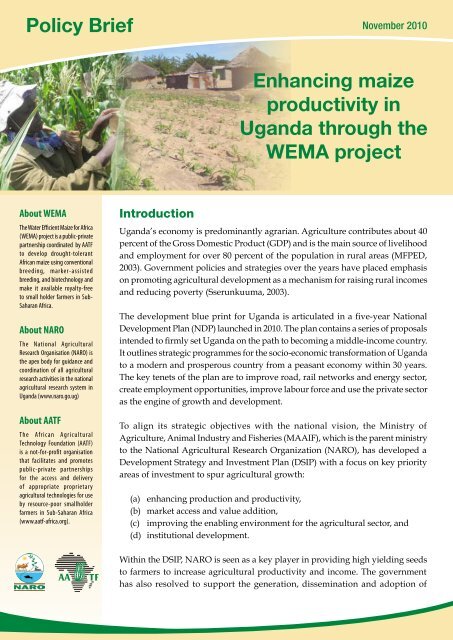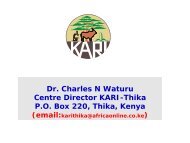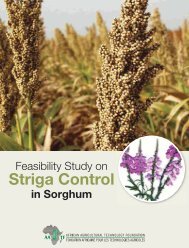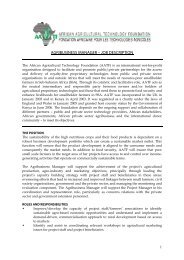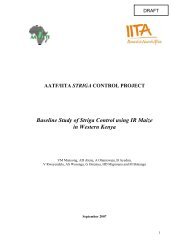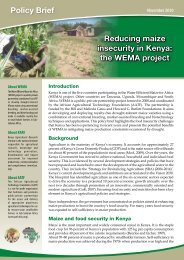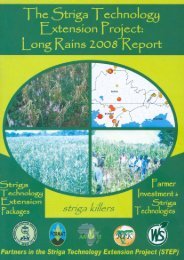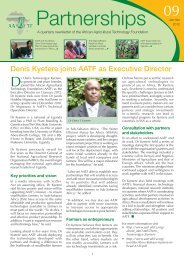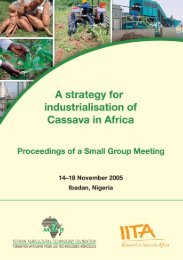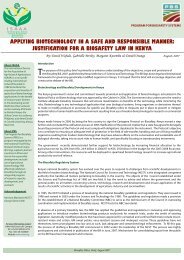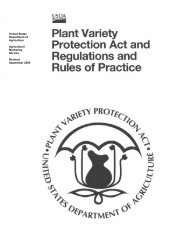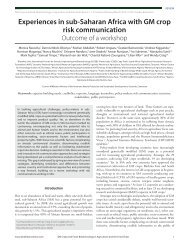Enhancing maize productivity in Uganda through the WEMA project
Enhancing maize productivity in Uganda through the WEMA project
Enhancing maize productivity in Uganda through the WEMA project
You also want an ePaper? Increase the reach of your titles
YUMPU automatically turns print PDFs into web optimized ePapers that Google loves.
Policy Brief<br />
November 2010<br />
<strong>Enhanc<strong>in</strong>g</strong> <strong>maize</strong><br />
<strong>productivity</strong> <strong>in</strong><br />
<strong>Uganda</strong> <strong>through</strong> <strong>the</strong><br />
<strong>WEMA</strong> <strong>project</strong><br />
About <strong>WEMA</strong><br />
The Water Efficient Maize for Africa<br />
(<strong>WEMA</strong>) <strong>project</strong> is a public-private<br />
partnership coord<strong>in</strong>ated by AATF<br />
to develop drought-tolerant<br />
African <strong>maize</strong> us<strong>in</strong>g conventional<br />
breed<strong>in</strong>g, marker-assisted<br />
breed<strong>in</strong>g, and biotechnology and<br />
make it available royalty-free<br />
to small holder farmers <strong>in</strong> Sub-<br />
Saharan Africa.<br />
About NARO<br />
The National Agricultural<br />
Research Organisation (NARO) is<br />
<strong>the</strong> apex body for guidance and<br />
coord<strong>in</strong>ation of all agricultural<br />
research activities <strong>in</strong> <strong>the</strong> national<br />
agricultural research system <strong>in</strong><br />
<strong>Uganda</strong> (www.naro.go.ug)<br />
About AATF<br />
Th e African Agric u ltu ral<br />
Technology Foundation (AATF)<br />
is a not-for-profit organisation<br />
that facilitates and promotes<br />
public-private par tnerships<br />
for <strong>the</strong> access and delivery<br />
of appropriate proprietar y<br />
agricultural technologies for use<br />
by resource-poor smallholder<br />
farmers <strong>in</strong> Sub-Saharan Africa<br />
(www.aatf-africa.org).<br />
Introduction<br />
<strong>Uganda</strong>’s economy is predom<strong>in</strong>antly agrarian. Agriculture contributes about 40<br />
percent of <strong>the</strong> Gross Domestic Product (GDP) and is <strong>the</strong> ma<strong>in</strong> source of livelihood<br />
and employment for over 80 percent of <strong>the</strong> population <strong>in</strong> rural areas (MFPED,<br />
2003). Government policies and strategies over <strong>the</strong> years have placed emphasis<br />
on promot<strong>in</strong>g agricultural development as a mechanism for rais<strong>in</strong>g rural <strong>in</strong>comes<br />
and reduc<strong>in</strong>g poverty (Sserunkuuma, 2003).<br />
Development Plan (NDP) launched <strong>in</strong> 2010. The plan conta<strong>in</strong>s a series of proposals<br />
<strong>Uganda</strong> on <strong>the</strong> path to becom<strong>in</strong>g a middle-<strong>in</strong>come country.<br />
It outl<strong>in</strong>es strategic programmes for <strong>the</strong> socio-economic transformation of <strong>Uganda</strong><br />
to a modern and prosperous country from a peasant economy with<strong>in</strong> 30 years.<br />
The key tenets of <strong>the</strong> plan are to improve road, rail networks and energy sector,<br />
create employment opportunities, improve labour force and use <strong>the</strong> private sector<br />
as <strong>the</strong> eng<strong>in</strong>e of growth and development.<br />
To align its strategic objectives with <strong>the</strong> national vision, <strong>the</strong> M<strong>in</strong>istry of<br />
Agriculture, Animal Industry and Fisheries (MAAIF), which is <strong>the</strong> parent m<strong>in</strong>istry<br />
to <strong>the</strong> National Agricultural Research Organization (NARO), has developed a<br />
Development Strategy and Investment Plan (DSIP) with a focus on key priority<br />
areas of <strong>in</strong>vestment to spur agricultural growth:<br />
(a) enhanc<strong>in</strong>g production and <strong>productivity</strong>,<br />
(b) market access and value addition,<br />
(c) improv<strong>in</strong>g <strong>the</strong> enabl<strong>in</strong>g environment for <strong>the</strong> agricultural sector, and<br />
(d) <strong>in</strong>stitutional development.<br />
With<strong>in</strong> <strong>the</strong> DSIP, NARO is seen as a key player <strong>in</strong> provid<strong>in</strong>g high yield<strong>in</strong>g seeds<br />
to farmers to <strong>in</strong>crease agricultural <strong>productivity</strong> and <strong>in</strong>come. The government<br />
has also resolved to support <strong>the</strong> generation, dissem<strong>in</strong>ation and adoption of
<strong>productivity</strong>-enhanc<strong>in</strong>g technologies <strong>in</strong>clud<strong>in</strong>g<br />
modern biotechnology. For <strong>in</strong>stance, <strong>the</strong> goal of<br />
<strong>the</strong> national biotechnology policy is to contribute to<br />
<strong>the</strong> national goals of poverty eradication, improved<br />
healthcare, food security, <strong>in</strong>dustrialisation and <strong>the</strong><br />
protection of <strong>the</strong> environment <strong>through</strong> <strong>the</strong> safe<br />
application of biotechnology.<br />
Build<strong>in</strong>g on <strong>Uganda</strong>’s vision and commitment for<br />
economic development and social transformation<br />
as conta<strong>in</strong>ed <strong>in</strong> <strong>the</strong> NDP and DSIP, <strong>the</strong> government<br />
signed <strong>the</strong> Comprehensive Africa Agriculture<br />
Development Program (CAADP) compact <strong>in</strong><br />
March 2010. CAADP commits <strong>the</strong> government to<br />
<strong>in</strong>crease <strong>in</strong>vestment <strong>in</strong> agriculture by a m<strong>in</strong>imum<br />
of 10 percent of <strong>the</strong> national budget and to raise<br />
agricultural <strong>productivity</strong> by at least 6 percent per<br />
year.<br />
<strong>project</strong>. O<strong>the</strong>r participat<strong>in</strong>g countries are Kenya,<br />
Tanzania, Mozambique and South Africa. <strong>WEMA</strong><br />
was launched to mitigate production constra<strong>in</strong>ts<br />
associated with drought. It is a public-private<br />
partnership <strong>project</strong> formed <strong>in</strong> 2008 and coord<strong>in</strong>ated<br />
by <strong>the</strong> African Agricultural Technology Foundation<br />
(AATF). The partnership is funded by <strong>the</strong> Bill and<br />
Mel<strong>in</strong>da Gates and Howard G. Buffett Foundations.<br />
The <strong>project</strong> aims at develop<strong>in</strong>g and deploy<strong>in</strong>g<br />
royalty-free drought-tolerant <strong>maize</strong> varieties us<strong>in</strong>g<br />
a comb<strong>in</strong>ation of conventional breed<strong>in</strong>g, markerassisted<br />
breed<strong>in</strong>g and biotechnology techniques<br />
and applications.<br />
This policy brief exam<strong>in</strong>es <strong>the</strong> potential of <strong>WEMA</strong><br />
<strong>in</strong> enhanc<strong>in</strong>g <strong>maize</strong> <strong>productivity</strong> <strong>in</strong> <strong>Uganda</strong>.<br />
The <strong>maize</strong> sub-sector <strong>in</strong> <strong>Uganda</strong><br />
Maize is widely grown <strong>in</strong> <strong>Uganda</strong> cover<strong>in</strong>g about<br />
50 districts. The ma<strong>in</strong> production agro-ecological<br />
zones are <strong>in</strong> <strong>the</strong> west, east, north and sou<strong>the</strong>ast<br />
<strong>Uganda</strong>. The crop is cultivated by over 3.6 million<br />
households on about 1.5 million hectares of land<br />
(UBOS, 2006). In terms of area planted, <strong>maize</strong> is<br />
<strong>the</strong> third most cultivated crop after banana and<br />
beans. In some regions of <strong>the</strong> country, <strong>the</strong> crop has<br />
now become a staple food, replac<strong>in</strong>g crops like<br />
sorghum, millet, cassava and banana. It is a grow<strong>in</strong>g<br />
source of household <strong>in</strong>come and foreign exchange<br />
<strong>through</strong> exports. For example, <strong>maize</strong> is presently<br />
considered a major source of <strong>in</strong>come <strong>in</strong> <strong>the</strong> districts<br />
of Kapchorwa, Mbale, Iganga, Mas<strong>in</strong>di and Kasese,<br />
with about 75–95 percent of <strong>the</strong> household harvest<br />
be<strong>in</strong>g sold to earn money. In 2008 alone, <strong>maize</strong> is<br />
estimated to have generated over US$ 18.5 million<br />
<strong>in</strong> export earn<strong>in</strong>gs from an estimated 66,700 tonnes.<br />
The regional dest<strong>in</strong>ations for <strong>maize</strong> exports <strong>in</strong>clude<br />
Kenya, Sudan, Rwanda, Burundi, Zambia and DR<br />
Congo. Kenya is <strong>Uganda</strong>’s largest importer of<br />
<strong>maize</strong>. The Kenyan formal and <strong>in</strong>formal market<br />
accounts for about 50 percent of <strong>the</strong> total <strong>maize</strong><br />
exports from <strong>Uganda</strong>.<br />
In <strong>the</strong> year 2007, <strong>Uganda</strong> produced about 1.2 million<br />
metric tonnes of <strong>maize</strong> (FAO, 2009). The country<br />
has a potential of produc<strong>in</strong>g up to 7.5 million<br />
metric tonnes utilis<strong>in</strong>g <strong>the</strong> current area under<br />
<strong>maize</strong>. However, this is never achieved largely<br />
due to various production constra<strong>in</strong>ts <strong>in</strong>clud<strong>in</strong>g<br />
low soil fertility, lack of improved <strong>maize</strong> varieties,<br />
erratic ra<strong>in</strong>fall patterns and drought stress dur<strong>in</strong>g<br />
some seasons. Maize production is generally<br />
characterised by low yields, which result <strong>in</strong> high<br />
unit costs and thus low returns. Regardless of <strong>the</strong><br />
farm sizes, <strong>Uganda</strong>’s <strong>maize</strong> yield levels are low and<br />
are generally between 1.0 and 1.8 metric tonnes/<br />
hectare (RATES, 2003). Crop failure due to drought<br />
can cause losses of up to 80 percent. The magnitude<br />
of <strong>the</strong> problem is high <strong>in</strong> districts such as Kasese<br />
where losses can reach catastrophic levels. O<strong>the</strong>r<br />
drought-prone regions <strong>in</strong>clude eastern, nor<strong>the</strong>astern<br />
and nor<strong>the</strong>rn <strong>Uganda</strong>.<br />
The <strong>WEMA</strong> <strong>project</strong><br />
The <strong>WEMA</strong> partnership was formed <strong>in</strong> response<br />
to a grow<strong>in</strong>g call by African farmers, leaders, and<br />
scientists to address <strong>the</strong> effects of drought <strong>in</strong> a<br />
way that is cost effective for African smallholder<br />
farmers.
oth public and private, and <strong>in</strong> <strong>the</strong> process expands<br />
<strong>the</strong>ir capacity and experience <strong>in</strong> crop breed<strong>in</strong>g,<br />
biotechnology, and biosafety. The benefits and<br />
safety of <strong>the</strong> <strong>maize</strong> varieties that will be developed<br />
will be assessed by national biosafety authorities<br />
accord<strong>in</strong>g to regulatory requirements <strong>in</strong> <strong>the</strong> partner<br />
countries.<br />
marker-assisted breed<strong>in</strong>g could be available after<br />
seven years of research and development. For<br />
<strong>the</strong> drought-tolerant varieties developed <strong>through</strong><br />
transgenic means, it is <strong>project</strong>ed that farmers could<br />
have access to <strong>the</strong> seeds between 2015 and 2017. This<br />
will take slightly longer because of <strong>the</strong> technology<br />
development pathway and <strong>the</strong> biosafety regulatory<br />
requirements that have to be addressed prior to<br />
commercial release.<br />
AATF works with <strong>the</strong> <strong>in</strong>ternationally funded non-<br />
Center (CIMMYT), <strong>the</strong> private agricultural company<br />
Monsanto, and <strong>the</strong> National Agricultural Research<br />
Systems (NARS) <strong>in</strong> eastern and sou<strong>the</strong>rn Africa <strong>in</strong><br />
this effort. Each partner br<strong>in</strong>gs unique expertise<br />
to <strong>the</strong> <strong>project</strong>. AATF contributes expertise <strong>in</strong><br />
leadership, public-private partnership management,<br />
technology stewardship and <strong>project</strong> management.<br />
CIMMYT provides high-yield<strong>in</strong>g <strong>maize</strong> varieties<br />
that are adapted to African conditions and<br />
expertise <strong>in</strong> conventional breed<strong>in</strong>g and test<strong>in</strong>g for<br />
drought tolerance. Monsanto provides proprietary<br />
germplasm, advanced breed<strong>in</strong>g tools and expertise,<br />
and drought-tolerance transgenes developed <strong>in</strong><br />
collaboration with BASF. The national agricultural<br />
research systems, farmers’ groups, and seed<br />
companies participat<strong>in</strong>g <strong>in</strong> <strong>the</strong> <strong>project</strong> contribute<br />
and distribution.<br />
The varieties developed <strong>through</strong> <strong>the</strong> <strong>project</strong><br />
will be distributed to African seed companies<br />
<strong>through</strong> AATF royalty-free and made available<br />
to smallholder farmers as part of <strong>the</strong>ir seed<br />
bus<strong>in</strong>ess. The <strong>project</strong> <strong>in</strong>volves local <strong>in</strong>stitutions,<br />
Conclusion<br />
<strong>WEMA</strong> is an important and relevant <strong>project</strong><br />
expected to contribute towards realis<strong>in</strong>g agricultural<br />
development and poverty reduction goals <strong>in</strong><br />
<strong>Uganda</strong> such as DSIP, <strong>the</strong> National Biotechnology<br />
and Biosafety Policy (2008), <strong>the</strong> new five-year<br />
National Development Plan (NDP) and <strong>the</strong> CAADP<br />
agenda. The partners will develop new African<br />
drought-tolerant <strong>maize</strong> varieties, <strong>in</strong>corporat<strong>in</strong>g<br />
<strong>the</strong> best technology available <strong>in</strong>ternationally. The<br />
long-term goal is to make drought tolerant <strong>maize</strong><br />
available royalty-free to small-scale farmers <strong>in</strong> Sub-<br />
Saharan Africa – most of whom are women – so <strong>the</strong>y<br />
can feed <strong>the</strong>ir families and <strong>in</strong>crease <strong>the</strong>ir <strong>in</strong>comes.<br />
The <strong>project</strong> will mitigate <strong>the</strong> adverse impacts of<br />
drought <strong>in</strong> chronically drought vulnerable districts<br />
such as Kasese, Karamoja sub-region, Nakasongola,<br />
Kiruhuura, and Buliisa among o<strong>the</strong>rs and<br />
streng<strong>the</strong>n <strong>the</strong> resilience of <strong>maize</strong> farmers to cope<br />
with <strong>the</strong> erratic climatic conditions. It is expected<br />
that commercialisation of <strong>maize</strong> varieties that will<br />
be developed under <strong>WEMA</strong> will translate to 25<br />
percent <strong>in</strong>crease <strong>in</strong> yields <strong>in</strong> drought-prone areas.<br />
The <strong>in</strong>creased yields will enhance food security,<br />
<strong>in</strong>crease household <strong>in</strong>comes of small holder farmers<br />
and government revenue generated <strong>through</strong> exports
to markets <strong>in</strong> <strong>the</strong> region. While appreciat<strong>in</strong>g <strong>the</strong><br />
success of <strong>the</strong> <strong>project</strong> will to a large extent be driven<br />
by a conducive policy environment, and strong and<br />
susta<strong>in</strong>ed political support. Policy makers with<strong>in</strong><br />
<strong>the</strong> relevant government <strong>in</strong>stitutions and agencies<br />
should create an enabl<strong>in</strong>g environment and make<br />
science-based decisions that will facilitate <strong>the</strong><br />
stages that will eventually pave <strong>the</strong> way for<br />
commercialisation. While <strong>Uganda</strong> has formulated a<br />
supportive biotechnology policy, <strong>the</strong> passage of <strong>the</strong><br />
biosafety bill and draft<strong>in</strong>g of enabl<strong>in</strong>g implement<strong>in</strong>g<br />
regulations should be accelerated to facilitate smooth<br />
and timely implementation of <strong>the</strong> <strong>WEMA</strong> <strong>project</strong>.<br />
References<br />
FAO, 2009. Maize Production Trends <strong>in</strong> <strong>Uganda</strong>.<br />
http://faostat.fao.org/site/339/default.aspx.<br />
MFPED/UPPAP. 2003. The 2 nd Participatory<br />
Poverty Assessment Report. Deepen<strong>in</strong>g <strong>the</strong><br />
Understand<strong>in</strong>g of Poverty, Kampala.<br />
MFPED, Background to <strong>the</strong> Budget, 2002/2003.<br />
<strong>Enhanc<strong>in</strong>g</strong> Production and Exports for Poverty<br />
Eradication. M<strong>in</strong>istry of F<strong>in</strong>ance, Plann<strong>in</strong>g and<br />
Economic Development, June 2002, Kampala,<br />
<strong>Uganda</strong>.<br />
RATES. 2003. Maize Market Assessment and<br />
Basel<strong>in</strong>e Study for <strong>Uganda</strong>. Regional Agricultural<br />
Expansion Support Program, Nairobi, Kenya.<br />
Sserunkuuma, D. 2003. The Adoption and Impact<br />
of Improved Maize Varieties <strong>in</strong> <strong>Uganda</strong>: A<br />
paper prepared for <strong>the</strong> Symposium on Green<br />
Revolution <strong>in</strong> Asia and its Transferability<br />
<strong>in</strong> Africa held on December 8–10, <strong>in</strong> Tokyo,<br />
Japan.<br />
UBOS. 2006. <strong>Uganda</strong> National Household<br />
Survey 2005/2006 Report. <strong>Uganda</strong> Bureau of<br />
Statistics.<br />
This policy brief is produced by <strong>the</strong> African Agricultural Technology Foundation (AATF) and <strong>the</strong> National<br />
Agricultural Research Organisation of <strong>Uganda</strong> (NARO) with contribution from Daniel Otunge, Nancy Muchiri,<br />
Grace Wachoro, Robert Anguzu and Peter Wamboga-Mugirya<br />
P. O. Box 295<br />
Entebbe, <strong>Uganda</strong><br />
Tel: 256 414 320342<br />
Fax: 256 414 321070<br />
Email: dgnaro@naro.go.ug<br />
Website: www.naro.go.ug<br />
P.O. Box 30709–00100,<br />
Nairobi, Kenya<br />
Tel: 254-(0)20-422 3700<br />
Fax: 254-(0)20-422 3701<br />
Email: aatf@aatf-africa.org<br />
Website: www.aatf-africa.org


